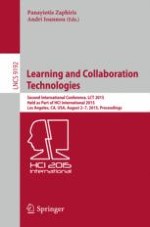The LNCS volume 9192 constitutes the refereed proceedings of the Second International Conference on Learning and Collaboration Technologies, LCT 2015, held as part of the 17th International Conference on Human-Computer Interaction, HCII 2015, in Los Angeles, CA, USA in August 2015, jointly with 15 other thematically similar conferences. The total of 1462 papers and 246 posters presented at the HCII 2015 conferences were carefully reviewed and selected from 4843 submissions. These papers address addressing the following major topics: technology-enhanced learning, adaptive and personalised learning and assessment, virtual worlds and virtual agents for learning, collaboration and Learning Serious Games and ICT in education.
